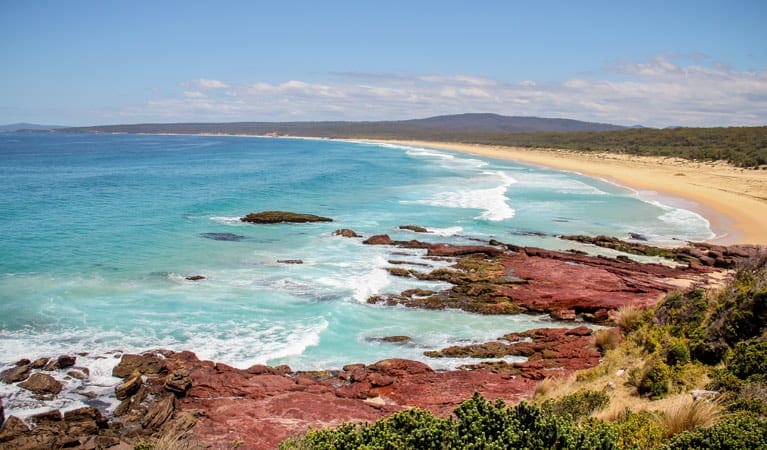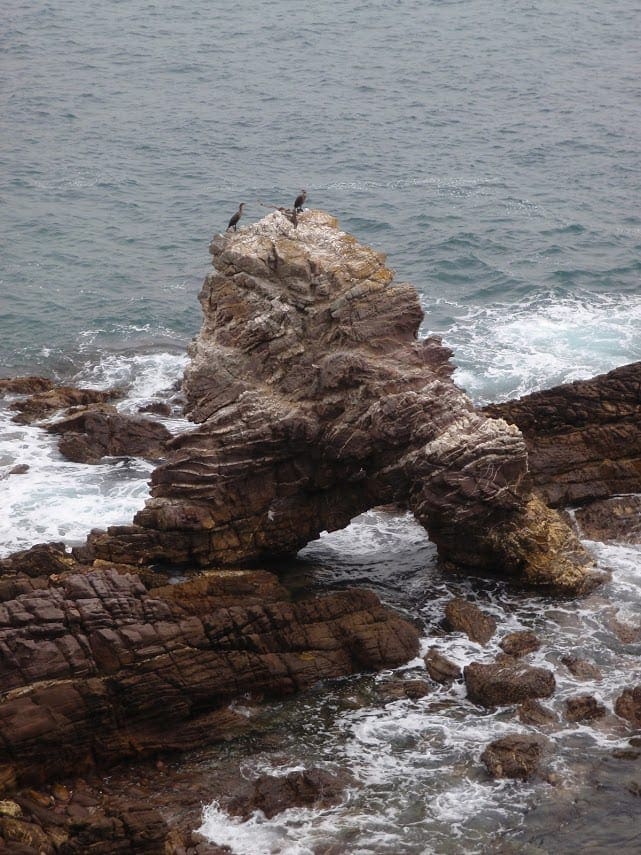Pinnacles loop walking track is a pleasant, easy walk that meanders through the woodland and heath of the NSW Far South Coast region. With beautiful coastal views south to Lennards Island and north to Haycock Point, it's an easy stroll for all the family in Beowa National Park, a short drive south of Pambula.
There are two lookouts along this gently undulating walking track that make ideal spots to view the fascinating Pinnacles formation - a spectacular erosion feature that consists of cliffs of soft white sands capped with a layer of red gravel clay. It was deposited during the Tertiary geological period - up to 65 million years ago.
Large areas of pine trees can also be seen between the eucalypts, and NPWS has been working to return the area back to its natural state.
It's a good idea to put sunscreen on before you set out and remember to take a hat and drinking water
Remember to take your binoculars if you want to go birdwatching or whale watching
Visit NSW National Parks and Wildlife Service for more information on this trail.
The longitude and latitude of the start and end points are approximately only and should not be used for navigation purposes. Please contact me if you know the correct coordinates.
Got some great shots from this hike? Upload your photos here to inspire others and show off the beauty of the trail!
Submitting your photos doesn’t mean you lose ownership. You can be credited for your contributions, and you can request removal at any time.
Please don’t copy GPX files or content from this site to AllTrails or other platforms. Each trail has been personally mapped, documented, and refined to support Australia’s bushwalking and hiking community. While some details come from land managers, every listing reflects significant personal effort. This is a free, community-driven initiative—your respect helps keep it that way.
It looks like I don’t have a GPX file for this trail yet. If you have one to share, please email it to me! I’ll verify it against official maps before adding it to help other hikers have a safer, easier experience. Thanks for contributing to a better hiking resource.
Getting there
Getting to the trailhead: Beowa (Ben Boyd) National Park.
To Pinnacles loop walking track carpark. Travel 10km south along Princes Highway from PambulaTurn left onto Haycock Road and travel 1kmTurn right at Pinnacles Road Park entry points Pinnacles loop walking track carpark See on map Parking Parking is available at Pinnacles loop walking track carpark.
Closest towns to this walk: Bega, Bemboka, Bermagui, Candelo, Cobargo, Eden, Merimbula, Pambula, Quaama, Sapphire Beach, Tathra, Towamba, Twofold Bay, Wyndham
About the region
Beowa National Park, formerly Ben Boyd National Park, spans 47km of rocky coastline and sheltered inlets. Located near the whale watching town of Eden on the far South Coast of NSW, its crystal clear waters are perfect for snorkelling and swimming.
Beowa National Park is separated into 2 areas, split by Twofold Bay. Take your pick from the sparkling lakes and surf beaches in the park's Pambula-Haycock area to the rocky cliffs and beachside campgrounds in the Green Cape area.
Its spectacular sea-carved landscape is a striking display of folded red rock platforms that contrast against the sapphire blue water of the ocean.
Similar walks nearby
Looking for more walks in or near Beowa (Ben Boyd) National Park? Try these trails with a similar difficulty grade.
Favourite

Beowa (Ben Boyd) National Park
Favourite

Beowa (Ben Boyd) National Park
Favourite

Beowa (Ben Boyd) National Park
Favourite

Beowa (Ben Boyd) National Park
Track grade
Grade 3 (Moderate) - Walks for Most Fitness Levels: Grade 3 on the
AWTGS represents moderate walking tracks. These are ideal for walkers with some fitness who are comfortable with some hills and uneven terrain. While suitable for most ages, some bushwalking experience is recommended to ensure a safe and enjoyable experience. Tracks may have short, steep hill sections, a rough surface, and many steps. The total distance of a Grade 3 walk can be up to 20 kilometers.
Explore safe
Plan ahead and hike safely! Carry enough water, pack layers for changing conditions, and bring safety gear like a torch, PLB, and reliable communication device. Check official sources for trail updates, closures, and access requirements, and review local weather and bushfire advice. Most importantly, share your plans with someone before you go. Being prepared makes for a safer and more enjoyable hike! Stay Safe, Explore More, and Always #ExploreSafe.
Packing checklists
What you carry in your pack depends on factors like weather, terrain, and your adventure type. Not sure what to bring? My free planning, food, and packing checklists are a great starting point, covering day hikes, overnight trips, and multi-day adventures. Use them to customise your kit and always prioritise safety.
Let someone know
Before heading out, take a moment to fill out your trip intentions form. It’s a quick way to share your hike details with family or friends. If something goes wrong, they can notify emergency services, ensuring a faster response and peace of mind. Stay safe and enjoy your adventure
Suggest an edit
Spotted a change on this trail? Maybe there are new features, the route has shifted, or the trail is permanently closed. Whatever the update, I’d love your input. Your feedback helps fellow hikers stay informed and ensures that our trail info stays fresh and reliable.






